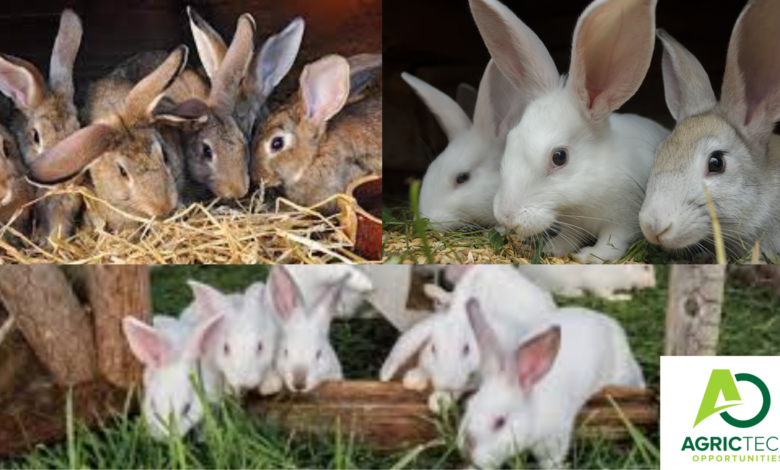The Ultimate Guide To Rabbit Production- WHY KEEP RABBITS

Host Country
GLOBAL
Target Audience
INTERNATIONAL (GLOBAL)
Program Overview
Rabbit farming has evolved from raising a few rabbits for a family’s needs to a large-scale commercial activity handling hundreds of rabbit production units.
Some rabbit proverbs
• “Underneath every bush you’ll find a rabbit ready to bolt.” – Darkovan
• “When the rabbit has escaped, comes advice.” – Spanish
• “A rat is not born a rabbit.” – Nigerian
• “If you chase two rabbits, you will not catch either one.” – Russian
• “A rabbit is never caught twice in the same place.” – American
• “Having vision as sharp as a kite and hearing as keen as a rabbit.” – Sicilian
ALSO CHECK: Starting Your Own Dairy Enterprises And Becoming A Dairy Farmer In South Africa
In this article we will be focusing on effective rabbit production, world rabbit production, Rabbits and rural development, and why we should keep rabbits advantages and disadvantages:
A typical part farm consists of 50 to 100 rabbits. A full-time operation requires at least 600 women (dos) and her 60 men (bucks). A single deer can produce 25-50 live rabbits per year yielding 125-250 pounds of meat. Angora rabbits produce 8 to 10 inches or 12 to 16 ounces of wool per year.
Rabbits are classified by weight and coat. Weight classes include small (3-4 lbs), medium (9-12 lbs) and large (14-16 lbs). Medium weight New Zealand whites are best for meat production, followed by Californian whites. Laboratory varieties depend on customer specifications. Angora rabbits are the only breed used for wool production.

Why keep rabbits?
•Meat
•high in protein and low in fat and cholesterol; easily digestible; good flavour; health benefits
•Specialty market
•Wool/fur
•Fine apparel
•Fancy
•Exhibitions and shows
•Laboratory research and teaching animal
•E.g., immunology studies, diagnostic research, eye research, human use products, etc.
•Provides good repeatability of animal model studies; large enough for single samples; many strains available; easily managed; ease to control reproduction; etc.
The rabbit advantage
1.Capital requirement is minimal. With some scrap wood or bamboo, a hutch can be constructed
2.Facilities take minimal space: backyard or indoor business.
3.A rabbit is a convenient ‘one meal size’, thus avoiding the need for storage
4.Rabbit keeping and consumption is restricted by few taboos or religious beliefs
5.Feeding rabbits costs much less than chickens (FCE for both chickens and rabbits is 2.5:1).
•ability to utilise forage (up to one third alfalfa meal in the diet) and concentrate diets efficiently as sources of needed nutrients
•Less competition in the food-feed debate
•Lower feed cost per unit product
6.Superior feed utilisation efficiency
•Rabbits kept for reproduction have capacity to convert 20% of their protein intake into meat compared to 16-18% for pigs and 8-12% for cattle
•Lower cost of energy compared with sheep or cattle (rabbit: 105 kcal/g of meat; mutton: 427 kcal/g; mutton: 442 kcal/g)
7.Small animal
•Can be produced by small, part-time growers; or as a alternate agricultural enterprise; or as a hobby
•Rabbits can be tended by women, children or men unlike bigger animals for it needs no force to be restrained
8.Higher turnover
•Because they produce offspring regularly rabbits form a regular source of income instead of a large amount at once
ALSO READ: Approved Principles Of Poultry Production For 2023/24
9.Reproductive efficiency
•High reproductive efficiency and short generation interval makes rearing of rabbits a highly attractive and profitable enterprise
•Rabbit is a prolific animal in terms of offspring (short gestation of 28-32 days; 4-5 litters per year, 8 kits per litter) will breed all year round
•It matures for table by 10 weeks (1.8-2.0kg), for breeding between 5–7 months
10.White meat
•White meat product that is high in protein and low in fat, sodium and cholesterol as compared to beef, lamb, pork and poultry
11.Several products and services
•rich manure for gardening or flower beds, fur, meat, buttons, pets, show purposes (fancy breeds).
12.Rabbit production is environmentally friendly
•no noise making, fierce fighting, attack on the husbandman or stench environmental pollution

World rabbit production
•Global rabbit meat production
•1994 – 1.5 million tones
•2015 – 1.8 million tonnes, 100 million animals slaughtered
•Per capita consumption – 2.3 kg, in 1994 was 280g/person
•Major production regions
•Asia (48.8%), especially China (735,021 t/year)
•Europe (28.4%), Italy, Spain, and France
•Americas (18.1%)
•Africa (4.7%), dominated by Egypt
•In Italy
•rabbit farming accounts for 9% of GDP (4th leading zoo-technical sector)
ALSO READ: The Power of Networking And Connections To Succeed For Interns 2023/24
Rabbits and rural development
•Rabbit meat production is becoming relatively important to the economy of Sub-Saharan Africa
•The development of sustainable programs for small-holder rabbit units is limited by
•Institutional policies
•Critical environmental conditions (heat stress)
•Housing design
•Feeding and management strategies
•Provision of suitable breeding stock
Rabbit industry in Zimbabwe
•Population – unknown
•Start-up capital for 10-50 breeding rabbits – $600- $1500
•Breeds: California White, Chinchilla, New Zealand White, New Zealand Red and Zika
•Market
•Restaurants, meat braai venues, meat shops, individuals, hotels or breeders
•Rabbit meat prices: $8 – $10/kg
•Commercial Rabbit Farming Book
Conclusively, The most important factors for a healthy rabbit herd are cleanliness, good ventilation, close observation, and protection from the sun and rain. can be lowered to Respiratory disease caused by Pasteurella multocida is responsible for low productivity and high mortality among women. Pasteurella-free animals can be purchased and can be a good investment.
ALSO READ: The Benefits of Doing an Internship: How It Can Help You Get Ahead in Your Career
For more updates On Agric Tech Opportunities kindly join the social groups below:
Join our Telegram | Follow us on Linkedin | Also, Follow us on Twitter. | Join Our Whatsapp Group
God bless and All the best !!



